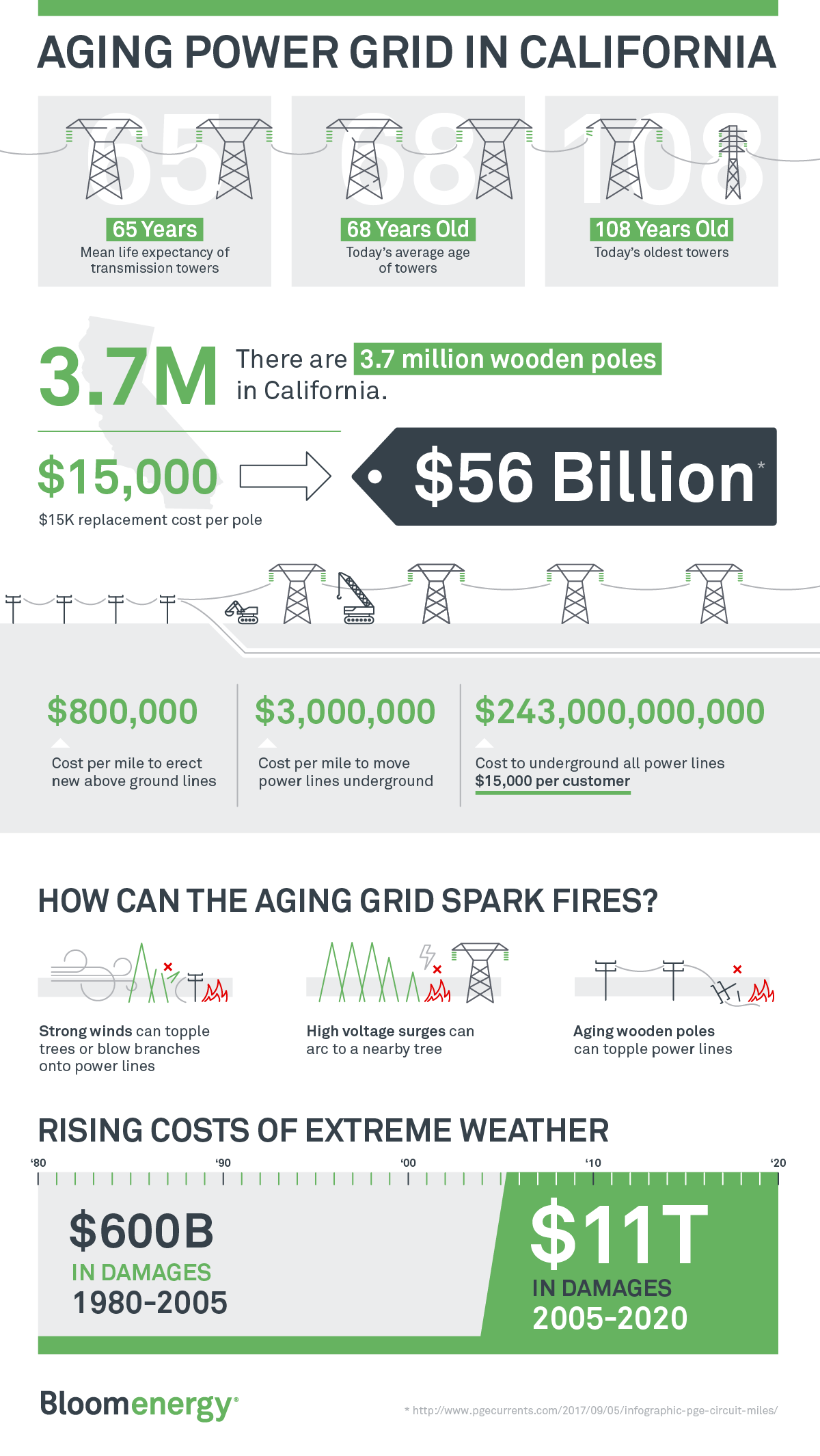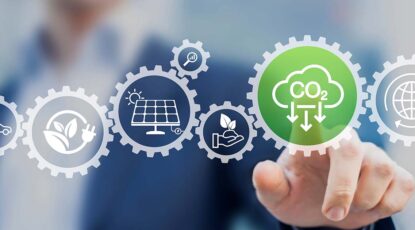We took a deep dive into three of the major energy trends we’re expecting to see in 2020: (1) an increasingly vulnerable grid will lead to a surge in microgrids, (2) the rise of massive power outages will bring energy resilience to the forefront of business strategies, and (3) the shipping industry will advance its path to sustainability by driving the adoption of cleaner power options.
1. Exposed grid vulnerabilities will drive adoption of microgrids
Power outages have nearly tripled over the past decade, impacting more businesses and communities than ever before.
Just this past year, California’s major utilities shut off power to millions of people in an attempt to reduce the risk of their electric equipment sparking fires – some were without power for nearly six days. That same week in October, a record-breaking bomb cyclone hit the Northeast and knocked out power for 600,000 customers. And, in July, a mid-summer blackout in New York City caused by “a flawed connection” plunged 72,000 customers into darkness.
In fact, there have been countless high-impact utility infrastructure failures and weather-related power disruptions over the past few years alone – all of which, have illuminated a dark reality for businesses and communities across the nation.
The current grid infrastructure is aging and vulnerable; it’s no longer equipped to reliably service us anymore.

Check out our California Power Outage Map to see when and where blackouts have occurred
Because the grid relies on centralized power generation with 200,000 miles of transmission lines and 5.5 million miles of distribution lines to deliver electricity to its destinations – which, most of the time, exist far from the power source – there are immeasurable opportunities for single points of failure that can quickly cascade through the system. What’s worse, most of the nation’s power lines were constructed in the 1950s and 1960s with a 50-year life expectancy.
This outdated grid infrastructure increases the risk of sparking wildfires during dry, windy conditions, which is ultimately what led to the preemptive Public Safety Power Shutoffs (PSPSs) we saw in California last year.
And we’re being warned that more PSPSs are to come – “Wildfire blackouts could be California’s new normal for the next 10 to 30 years, or even longer,” senate energy committee chair Lisa Murkowski voiced in a hearing on utility and fire safety in December.
“People are rightly asking why we rely on century-old technology and a transmission network of thousands of miles of overhead electrical lines strung on wooden poles across a landscape that has become a tinderbox,” said KR Sridhar, Bloom Founder and CEO in a recent CalMatters op-ed.
“In California, we pride ourselves on technological innovation. Which is why the outdated grid frustrates so many of us.”
KR SridharFounder and CEO, Bloom Energy
Beyond just California, the approach to power must evolve – and we think 2020 will be the year that microgrids rise to the top.
Because microgrids generate power onsite right where the electricity is consumed, they avoid the vulnerabilities (and costs) of the conventional transmission and distribution system. They also avoid the associated dangers of running aging power lines through high fire risk areas.
A truly 21st century technology, microgrids flip the traditional energy paradigm – they provide primary power onsite and treat the grid as backup.
With extreme weather events on the rise, the nation’s antiquated grid infrastructure will increasingly struggle. And with more frequent and longer-lasting power outages on the horizon, businesses and communities are likely to take their energy needs into their own hands.
Peter Asmus, who studies energy generation for Navigant Research, sees a microgrid surge coming: “My sense is microgrids are going to take off,” he says.
2. Energy resilience will elevate to a C-suite and boardroom level issue
Half of CFOs are playing a larger role in energy decisions than they did five years ago, according to ENGIE’s recent “Energy in the C Suite” survey.
What’s driving this trend? Based on the events of 2019, we’re placing our bet on the same thing that’s driving a microgrid surge – the rise of massive blackouts and the stark lack of security in today’s power grid.
As outages increase, businesses are considering the “cost of not having power” instead of just the “cost of power.” Energy resilience is becoming an issue business leaders can no longer afford to neglect – both from a strategic and cost perspective.
Take California’s multi-day PSPSs. These outages knocked out power for more than 100,000 businesses in October of 2019. Hospital chains Sutter Health and Adventist Health were forced to cancel procedures and close facilities. Some Trader Joe’s and other supermarkets shuttered for days. Factories scrambled to find backup generators and fuel to remain operational.
No matter the cause, when businesses experience long-duration outages, the impacts are colossal. The price tag for one hour of downtime for large enterprises is millions of dollars. When you start considering the multi-day outages that hit last year, that number can climb to the hundreds of millions – for a single business.
As corporate financial decision-makers confront increasing power outages and their impact on business continuity, they’re forced to reconsider their energy strategies.
We agree. Power availability and quality is reaching the C-suite, no matter the industry. In a climate change era, sustainability has already cemented itself into top level business strategies – now resiliency will follow.
Energy resilience is becoming a strategic aspect of business success, in 2020 and beyond.
3. Alternative, cleaner power options for the shipping industry will continue to proliferate
In 2018, the shipping industry kicked off its decarbonization journey with an ambitious emissions strategy. The International Maritime Organization (IMO), an arm of the United Nations, stated a new mandate for all shipbuilders to cut their emissions 50 percent, compared to 2008 levels, by 2050 – provoking important discussions and inspiring some preliminary action (e.g. shipping giant Maersk’s net-zero emission target).
A recent report highlighted that the transition won’t be easy, or cheap. It estimates a $1 trillion price tag on cutting ship carbon emissions to meet the IMO target.
January 1, 2020 marked the first day that new IMO regulation, Sulfur 2020, took effect. The regulation substantially limits the amount of sulfur permitted in marine fuel, from 3.5 percent to 0.5 percent. This landmark limit has immense implications for the industry – it means ships can no longer burn heavy fuel oil or bunker fuel, which currently account for 80 percent of the world’s shipping fleet fuel supply.
According to the IMO, combustion of heavy fuel oil not only harms the environment by leading to acid rain and ocean acidification, it also significantly harms human health by causing respiratory symptoms and lung disease. In fact, it’s estimated that if the 2020 sulfur limit wasn’t implemented, air pollution from ships would contribute to more than 570,000 additional premature deaths over the next five years.
As the industry’s emissions and fuel requirements evolve, so must its energy strategy. There are a multitude of options for shipping companies, each of which has its own unique set of advantages and challenges. Some approaches include switching to low sulfur (but expensive) fuels, installing scrubbers to remove sulfur oxide (SOx) from emissions as a mid-term measure, and making a long-term switch to LNG as fuel.
Regardless of the specific path forward, one thing is clear – the IMO’s uncompromising stance demands action from the industry.
And indeed, some action has already begun. Take Bloom’s recent collaboration with Samsung Heavy Industries (SHI) as an example. By combining Bloom’s proven, clean power generation on land and SHI’s shipbuilding prowess, we aim to deliver an ocean-going ship powered by fuel cells running on natural gas. This will not only play a key role in helping SHI exceed the IMO’s carbon emissions mandate, but also will help limit air pollutants, such as nitrogen and sulfur oxides, and achieve energy efficiency improvement targets.
Similar to the Bloom-SHI collaboration, we predict there will be a proliferation of innovative technologies and partnerships in 2020 to help shipbuilders make strides on sustainability goals and IMO mandates.



